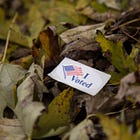This week’s graph shows the number of men and women who have voted in Australian federal elections from 2010 to 2025. The number of voters is depicted by the bars and aligned with the left y-axis. The sex difference in voter turnout is depicted by the line and filled circles and is aligned with the right y-axis.
Key Points
Fewer men than women vote in Australian federal election. This result has been observed consistently since at least 2010.
Each year, approximately 400,000 to 500,000 fewer men than women vote in Australian federal elections.
The sex difference in voter turnout in Australian federal elections has been less in more recent elections compared to elections held in 2010 and 2013. However, the difference appears to have plateaued at round 400,000 fewer male than female voters in the past few federal elections.
In 2025, 9,253,749 million women and 8,826,037 men voted in the Australian federal election – a difference of 427,712 voters.
Source: Spreadsheets published by the Australian Electoral Commission.
Bonus Commentary
On May 3, 2025, Australia held its latest federal election. Voter turnout was less for men than women. Approximately 400,000 fewer men than women voted in the election. This sex difference was consistent with previous federal elections in Australia and with lower male than female voter turnout in the United States (U.S.).
Voting is compulsory in Australia. Citizens who do not vote in federal elections pay a $20 fine. Citizens who do not vote in state elections pay heftier fines. In Western Australia, the fine for not voting in state elections is $50-$75. In New South Wales, the fine for not voting in state elections is $55. Because of its compulsory voting policy, Australia is an interesting case study for examining reasons for lower male than female voter turnout. Presumably, compulsory voting minimizes the influences of certain factors, such as political apathy. Some politically apathetic individuals are probably more likely to vote when they know there exists a financial penalty for not doing so.
Previously, I published a non-exhaustive list of reasons why voter turnout is less among men than women in the U.S. This list included the following reasons:
Fewer men than women are registered to vote
Men are more likely than women to work full-time jobs
More men than women commit felonies and are in jail
Men are more likely than women to be overseas in the military
The lifespan gender gap (i.e., the life expectancy difference)
Men have lower education levels than women
Many of the above reasons will also apply to Australian voters. For example, life expectancy is shorter for males than females in the U.S. and Australia. Thus, in both countries, there are fewer men than women of voting age to event cast a ballot.
Lower male than female voter turnout impacts election results. On average, men and women hold different views on specific political issues and on what the role of government ought to be. Women are more likely than men to vote for left-leaning political parties, and men are more likely than women to vote for right-leaning political parties. Thus, women are more likely than men to prefer bigger government, and men are more likely than women to prefer smaller government. This is true in Australia, the U.S., and other countries. Underlying psychological reasons for sex differences in voting preferences include greater female than male risk aversiveness, greater female than male preference for “equality” over efficiency, lower female than male competitiveness, and lower female than male self-confidence.
Lower male than female voter turnout is a men’s health issue that few people are talking about.
Related Content at The Nuzzo Letter
SUPPORT THE NUZZO LETTER
If you appreciated this content, please consider supporting The Nuzzo Letter with a one-time or recurring donation. Your support is greatly appreciated. It helps me to continue to work on independent research projects and fight for my evidence-based discourse. To donate, click the DonorBox logo. In two simple steps, you can donate using ApplePay, PayPal, or another service. Thank you!









Interesting, thanks Jim. Compulsory voting? How about that. I think I might add one idea to your list....when you see clearly the system is rigged against you, it lowers the probability of thinking voting is necessary.
The prison population in Australia is around 44,000. While voting is compulsory, prisoners serving sentences of more than three years are ineligible to vote. In practice very few prisoners actually vote (274 at the last election - see the following link). Since around 95% of prisoners are male, this may be one reason for the discrepancy in the number of votes cast by male and female voters.
It would be interesting to find out from the AEC how many male and female voters are enrolled in Australia, and how many males and females are eligible to vote but yet to enrol. That would help to clarify whether the discrepancy is due to there being more enrolled female voters, and whether apathy is a contributing factor.
https://www.sbs.com.au/news/article/just-274-prisoners-voted-at-the-last-election-inmates-say-the-process-feels-dehumanising/tnfeep1oo